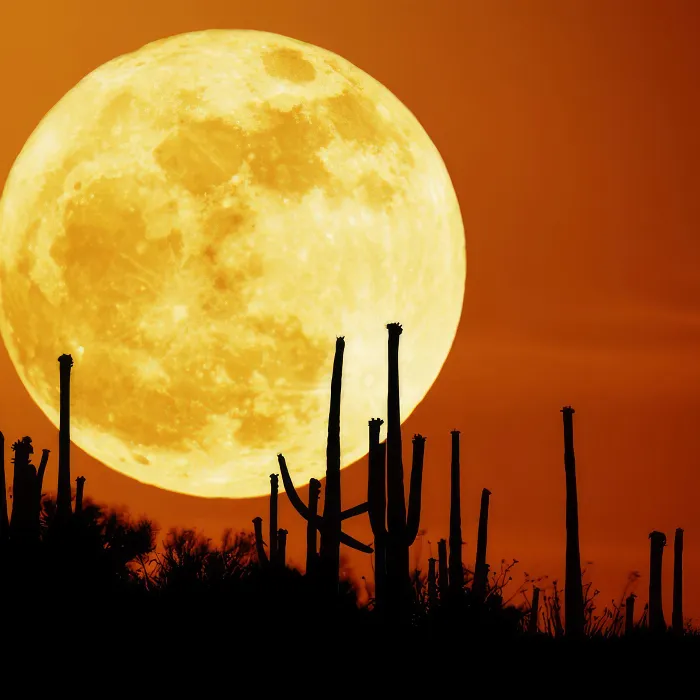It is no easy task to find the right telescope for your needs and budget from the wide range on offer.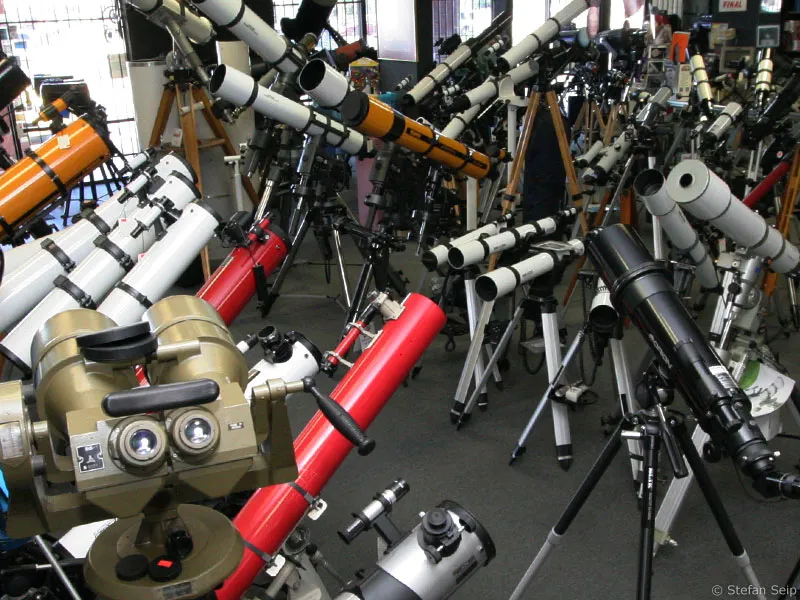
Part 13: Which telescopes are suitable for astrophotography
Anyone who is interested in astronomy in general and astrophotography in particular will sooner or later feel the need for their own telescope. Although visual observations can be made with the naked eye or binoculars and even impressive astrophotos can be taken without a telescope (see parts 1 to 4 of this tutorial series), a telescope provides access to countless smaller and/or fainter celestial objects.
The range of telescopes on offer is huge and initially almost unmanageable, the advertising promises are full-bodied. This tutorial will therefore deal with the question of which telescopes are suitable and can be recommended for astrophotography. To anticipate this: There is no 'best' telescope for all purposes. The designs and optical systems on offer each have specific advantages and disadvantages, some can be used reasonably well for a wide range of applications, others are specialists and only show their advantages when observing certain objects. And even a large, powerful telescope can be the wrong choice if its size and weight mean that it is rarely used because handling and transportation are too much effort and trouble.
Basically, it should be noted that a telescope for astrophotographic purposes must meet significantly higher requirements than a device for visual observation of the sky. While telescopes in the lower price segment can also be suitable for purely observing, the only choice for photography is better, but also more expensive models.
Here is a selection of points that are important:
- Image quality
On the optical axis, every telescope with precise optics delivers an acceptable image quality. This is sufficient for visual purposes, but for photography it is important that the stars are also imaged sharply off the optical axis - preferably right into the corners of the image. The larger the image sensor in the camera used, the more difficult it is to meet this requirement.
- Illuminated field
Most telescopes are not capable of illuminating a "full-frame sensor" of 24x36 millimetres without vignetting; this results in dark corners in every image. Even with "APS-C format" sensors (1.6x crop, 15x22 millimetres), some telescopes still show weaknesses in this discipline.
- Focuser
When using a digital single-lens reflex camera (DSLR), a focuser with a minimum diameter of two inches must be available. However, the mechanical design of the focuser is also important. It should be stable enough so that no tilting occurs after connecting a heavy DSLR (compared to an eyepiece). A reduction of the focusing mechanism is advantageous for precise and sensitive focusing.
Stable 2-inch focuser with reduced focusing mechanism: The large black wheel is used for coarse focusing, the gold wheel has a tenfold reduction and enables sensitive adjustment.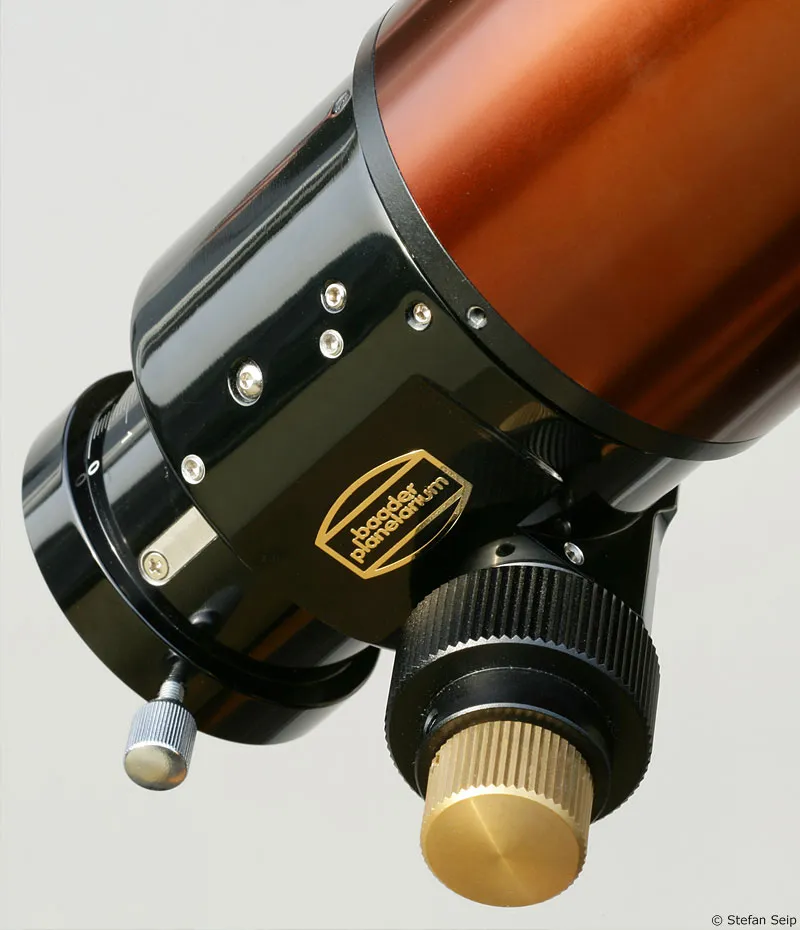
This focuser from Meade also offers a gear reduction for focusing. In the area of the blue ring, it is also possible to rotate it around the optical axis in order to set the best image section.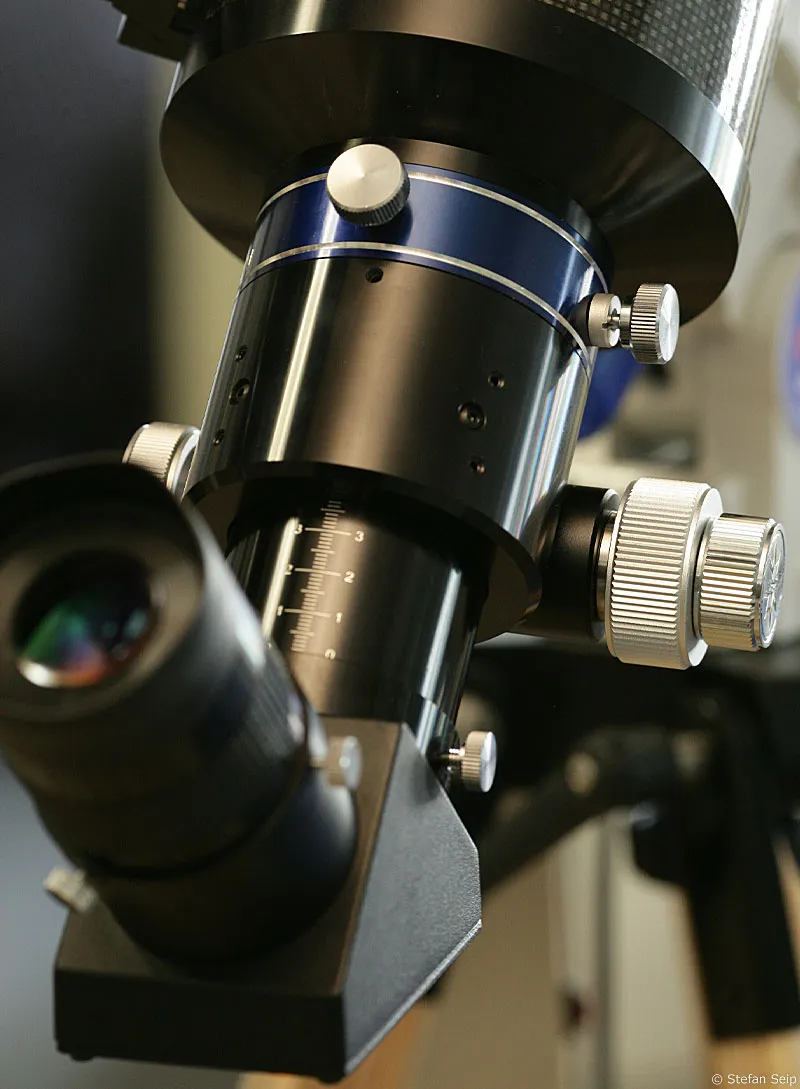
This 1.25-inch focuser is too small to connect a digital SLR camera to it. The chrome finish belies the fact that it is made entirely of plastic and cannot meet photographic requirements in terms of stability.
- Temperature stability
The temperature usually drops continuously during the night. Depending on the materials used for the tube and focuser, this can cause the focus point to shift and frequent refocusing may be necessary. A device that never or only rarely needs to be repeatedly refocused despite the falling temperature is more enjoyable.
- Image field flattening
Most optical systems of amateur telescopes suffer from image field curvature, i.e. the focal plane is not a plane but a hemisphere. This inevitably leads to partial blurring in the photos, depending on which point is being focused on. The larger the image sensor, the more problematic this becomes. This can be remedied by an image field flattening lens specially "calculated" for an optical system, but this is not available for all telescopes.
- Focal ratio
The focal ratio is calculated by dividing the focal length by the free aperture of the front lens or primary mirror. The result is a number that is identical to the Blender of a photographic lens. The smaller the number, the faster the telescope. A high light intensity means short exposure times, which is a great advantage when photographing low-light deep-sky objects. Because of the short exposure times, fast optics are also referred to as "fast", while those with low light intensity are referred to as "slow".
- Image errors (aberrations)
Only telescopes whose aberrations are so small that they are not recognizable in the photos, or only with difficulty, can be used for photography.
The resolving power and the ability to collect as much light as possible depends solely on the free diameter of the telescope objective (lens or mirror), which astronomers like to call the aperture and is given in inches (1 inch = 2.54 centimetres). For photography, however, the aperture ratio, i.e. the Blender, is more important, as the resulting exposure time depends on it. Of course, if you want longer focal lengths with a "fast" focal ratio, this automatically results in large apertures.
In any case, it should be noted at this point that the price, weight and dimensions of a telescope increase very quickly with increasing aperture.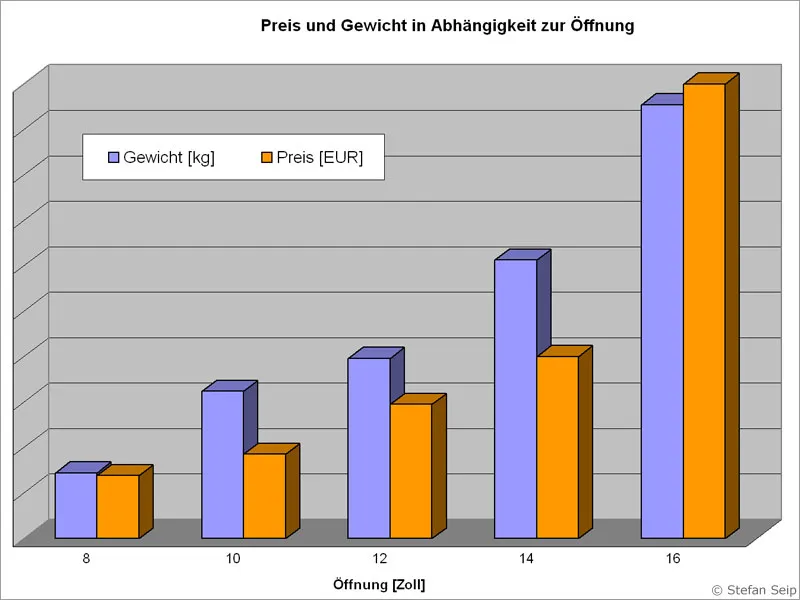
Development of weight and price as a function of telescope aperture. The graph is based on the ACF series from Meade, but the trend can be applied to practically all other telescopes. Absolute prices and weights do not play a role in this illustration and have been omitted.
In addition to these requirements, individual wishes and preferences are of course also important when choosing a telescope. In particular, the focal length in combination with the sensor format determines the effective angle of view. While extended celestial objects such as the Andromeda galaxy or the Orion Nebula can be photographed with a focal length of 500 millimetres, smaller objects such as the Ring Nebula or a planet require a significantly longer focal length.
Lenses or mirrors?
A fundamental distinction in telescopes can be made by looking at the optical components that produce the image. If the objective consists only of lenses, it is referred to as a refracting telescope or refractor. If only mirrors serve as the objective, it is a reflector telescope or a reflector. If both mirrors and lenses produce the image, it is called a catadioptric system.
1. the refracting telescope (refractor)
The refractor is the closest thing to what a layman would think of as a telescope: At the front end of the tube is an objective consisting of at least two lenses, while at the rear end the camera is connected without any other optical elements. A refracting telescope is therefore a very simplified form of a telephoto lens with a fixed focal length. However, telephoto lenses have a more complex design, so that their overall length is shorter than the effective focal length. This is not the case with refractors, so that the overall length corresponds approximately to the actual focal length.
Schematic representation of a refractor. The starlight enters from the left, hits the objective made of glass lenses and is concentrated by these on the sensor of the camera in a focal point.
Refractors suffer from the problem of chromatic aberration, a longitudinal color error caused by the fact that the light is refracted differently in the lenses depending on the wavelength.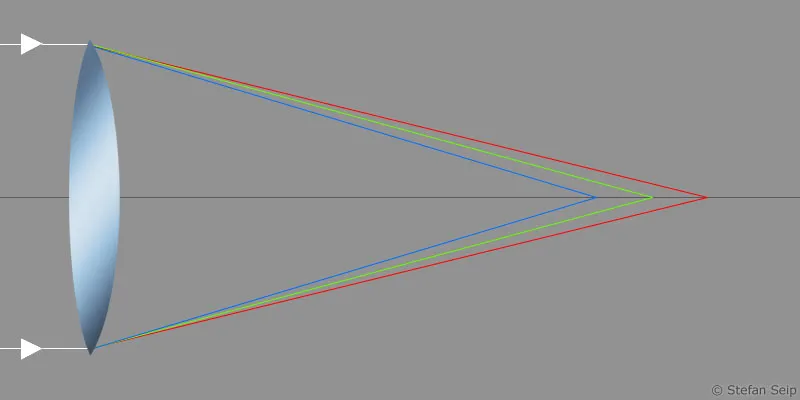
Schematic representation of the longitudinal color error (chromatic aberration): A lens also acts as a prism and splits the light into its components. A different focal point is created for each wavelength (=color).
A lens therefore simultaneously acts as a prism and splits the light into its spectral components. The consequence of this is that a single-lens lens has no real focal point, but combines the colors blue, green and red in differently positioned focal points; the overall result is a "focal line". The effective focal length for red light is longer than that for blue light. Such a lens, known as a chromat, is simply unusable for both visual observation and photography because the image quality is unacceptable due to the pronounced, colored halos around the stars. For this reason, chromatic lenses can only be found in "toy telescopes".
An improvement is achieved by using an objective consisting of two lenses cut from different glasses. This allows at least two of the three main wavelengths to be combined in one focal point. However, the focal position of the third (in practice usually the blue light) is still different, so that blue halos appear disturbingly in the photos of bright stars despite the best focusing. Telescopes of this type are known as achromats or Fraunhofer telescopes and are relatively inexpensive. They are not suitable for photographic purposes, or only to a very limited extent, due to the remaining color error. The faster a refractor lens is, the greater the effect of chromatic aberration.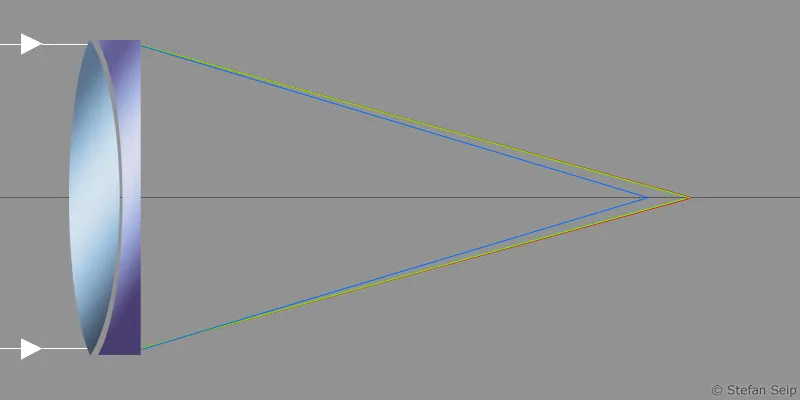
Schematic representation of an achromatic lens: Two lenses made of different types of glass are combined in such a way that at least two main wavelengths (here red and green) are united in a common focal point, while the blue light continues to have a different focal position.
The achromatic refractor from Bresser with a 5 inch aperture and integrated field flattening lens is already a formidable instrument. The remaining color error will be noticeable in the form of blue halos around bright stars. Cost: 480 euros.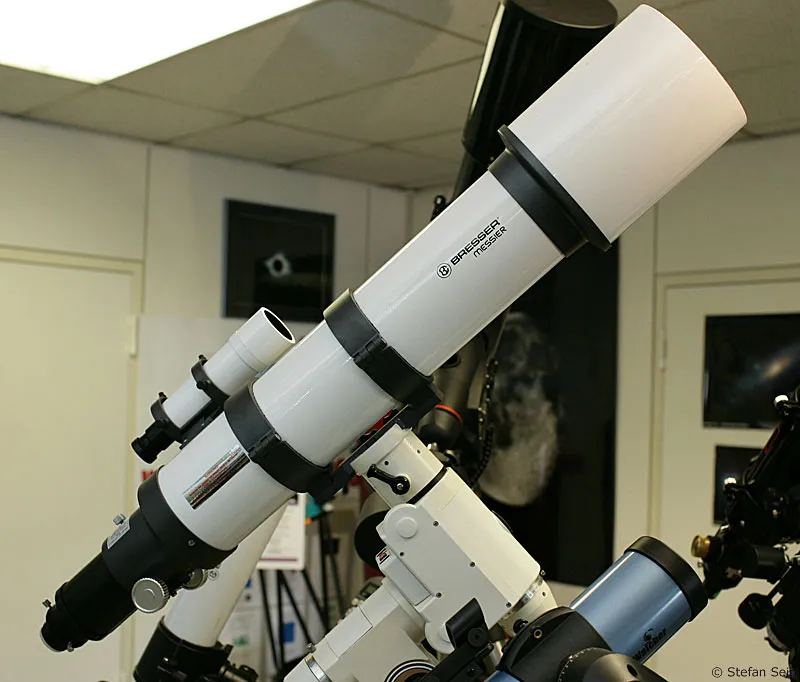
After removing the dew cap, the objective of this refractor shows three pairs of adjustment screws (one tension and one compression screw). This allows the objective to be positioned so that the optical axis coincides with the central longitudinal line of the tube. In practice, however, this type of adjustment will only be necessary very rarely. The greenish shimmering coating of the lenses prevents large light losses due to reflection.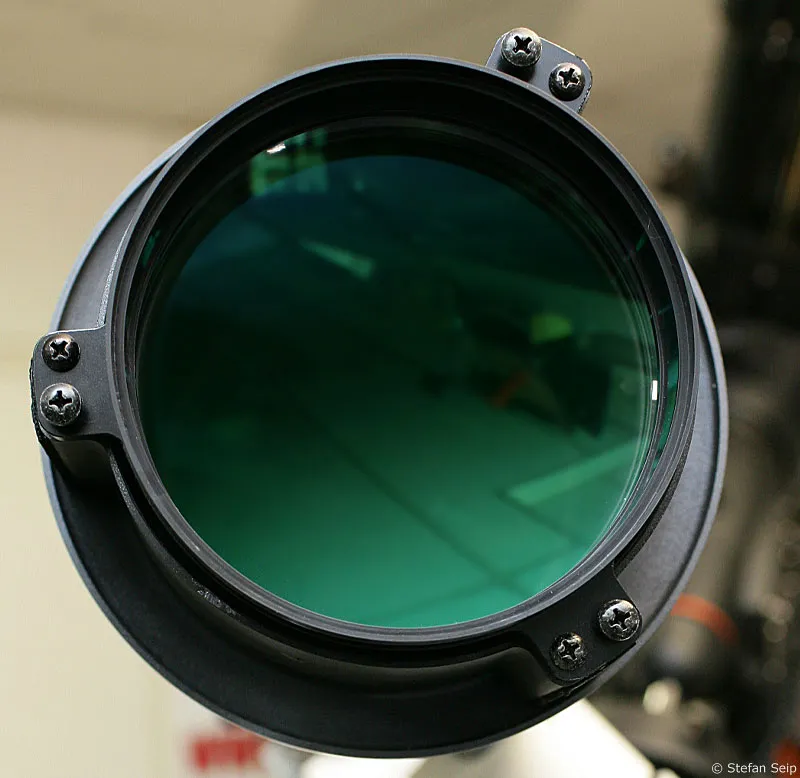
| Achromatic refractor | |
| Typical apertures | 3 to 6 inches |
| Typical aperture ratios | 1:5 to 1:11 |
| Manufacturer (examples) | Vixen, Meade, Bresser, Skywatcher |
| Price range (approx.) | 150 to 900 Euro |
The most perfect form of refractor is the apochromat, in which a mostly three-lens objective completely eliminates chromatic aberration or at least reduces it to such an extent that it no longer plays a role in practice. One of the lenses is made from an exotic and expensive type of glass so that three wavelengths can be combined in a single focal point. The result is a completely color-clear image without disturbing color fringes at the edges of bright objects. Unfortunately, the terms apochromat and the corresponding adjective apochromatic are not subject to any industry standard, so that there are certainly devices on the market that bear the name apochromat, but in practice have a visible residual chromatic aberration.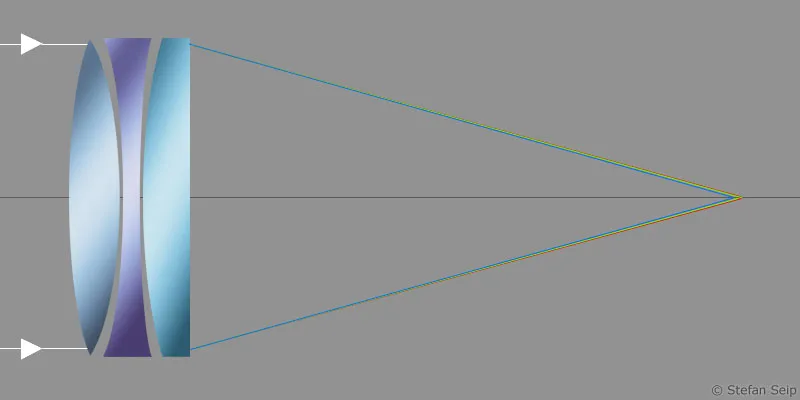
Schematic diagram of an apochromat: A (usually) three-lens objective is able to focus practically all wavelengths at a common focal point - the result is a photo without any discernible chromatic aberration. One of the lenses must be made of an expensive special glass.
This apochromat has 90 millimetres and images largely in pure color. The manufacturer is William Optics and the price is above 800 euros.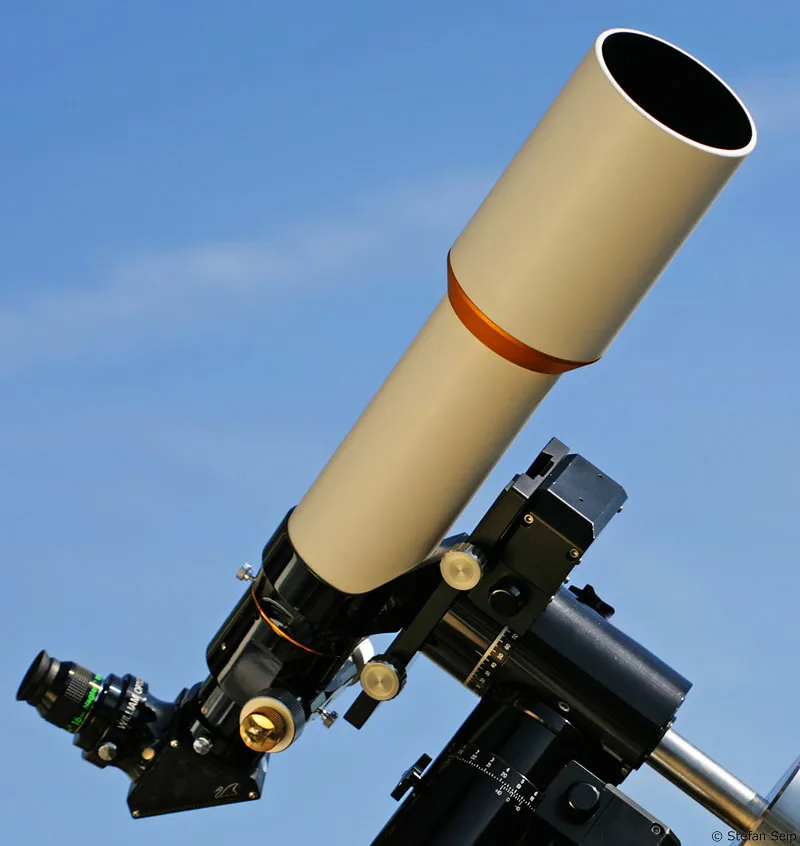
A look at the lens reveals a high-quality coating, as the lenses are almost imperceptible. The focal length is 621 millimeters, the focal ratio 1:6.9.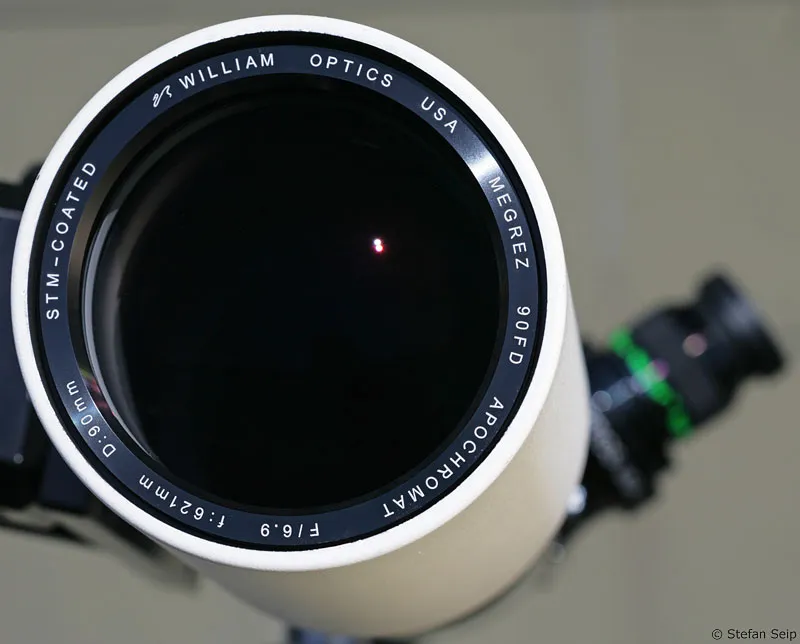
Apochromats from the manufacturer LZOS are among the best corrected refractors in the world. Shown here is a lens with an aperture of 115 millimeters (4.5 inches) and a focal length of 805 millimeters (Blender 1:7). Including tube and focuser, it costs over 3000 euros.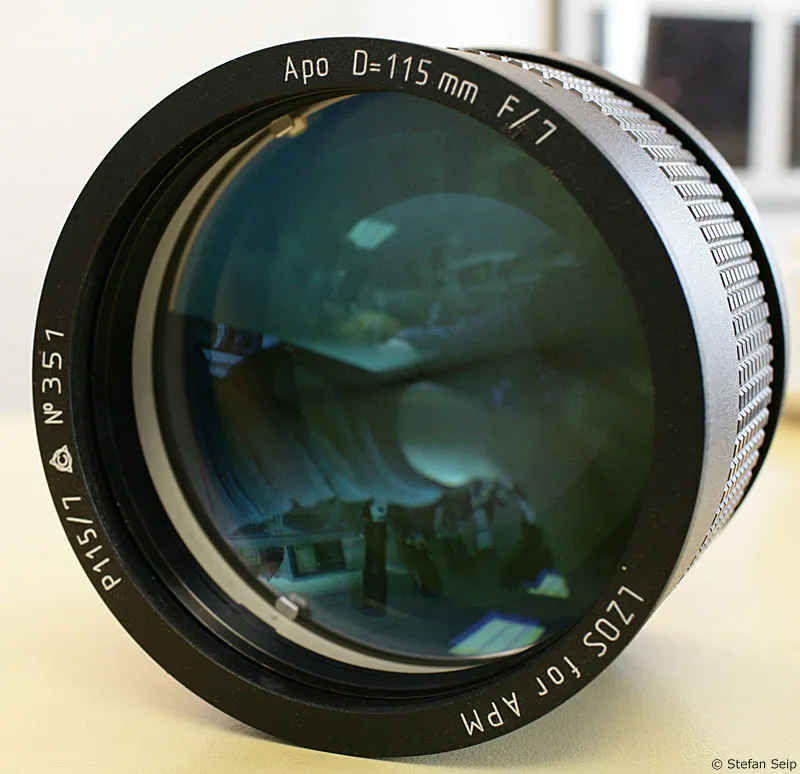
Two apochromats from Astro-Physics: The white telescope is a 6.1-inch refractor (155 millimetres aperture) with a focal ratio of 1:7, the smaller, mounted telescope is an apochromat with a 4.1-inch aperture at Blender 1:6 (focal length 630 millimetres). You can clearly see what a difference two inches of aperture makes in terms of size and weight.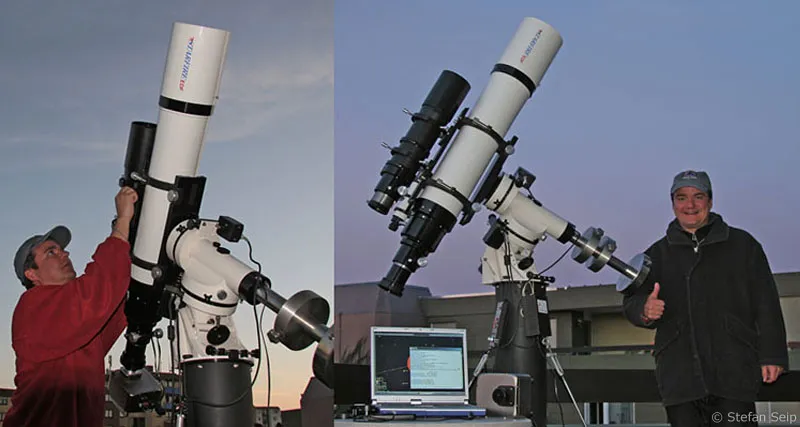
Refractors with an aperture of more than 7 inches are hardly transportable. The large device in the following photo is a 10-inch apochromat with an aperture of 1:14, the smaller device on top is a 5.1-inch apochromat with an aperture of 1:8. They are permanently mounted in the dome of the Welzheim Observatory.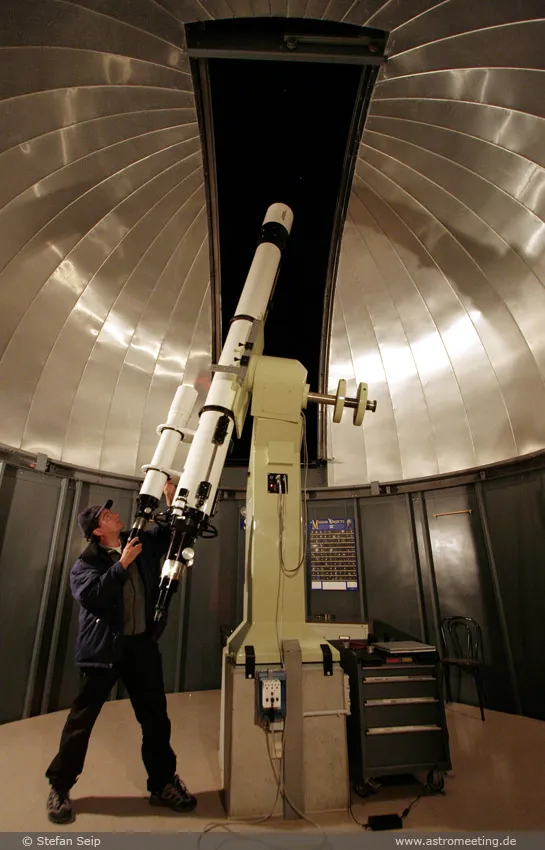
| Apochromatic refractor (Apo) | |
| Typical apertures | 2.5 to 8 inches |
| Typical aperture ratios | 1:5 to 1:8 |
| Manufacturer (examples) | LZOS, Astro-Physics, Takahashi, TEC, William Optics |
| Price range (approx.) | 800 to 25,000 euros |
Between the achromat and the apochromat are the ED, semi-apochromats or semi-apochromats, in which a visibly better color correction is achieved with a mostly two-lens objective than with the achromat, but without achieving the perfection of a true apochromat.
This is made possible by using a special glass for one of the two lenses. In terms of price, these devices are quite interesting and the photographic performance of some models is also impressive.
Semi-apochromats often bear the additional designation "ED". The correction of chromatic aberration is considerably better than that of an achromat, without achieving the perfection of a true apochromat. The price/performance ratio must be described as balanced and attractive. This device with an aperture of 80 millimetres and a focal length of 600 millimetres is available for as little as 350 euros: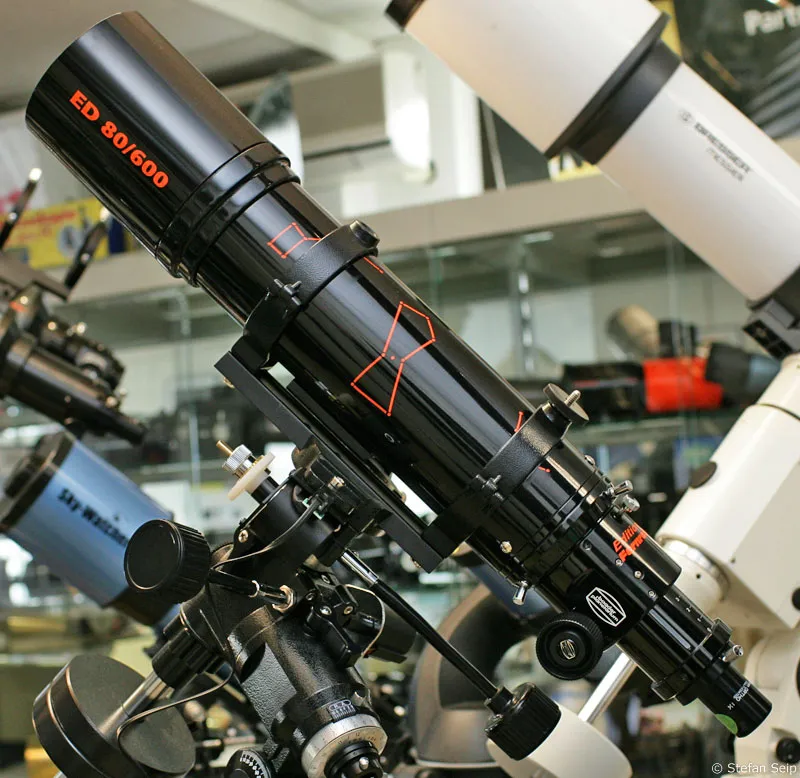
This ED refractor has 100 millimeters aperture (4 inches) and 900 millimeters focal length (focal ratio 1:9). Its price is around 700 euros.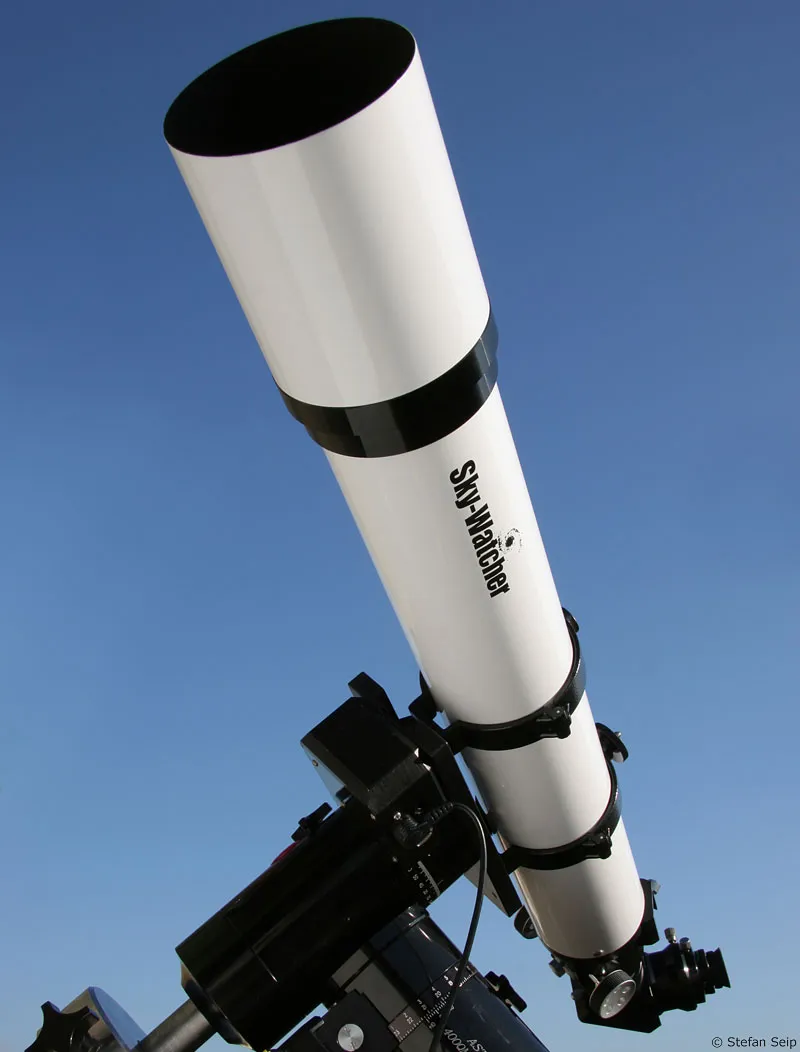
View of the (non-adjustable) objective of the ED-60/800 refractor shown above: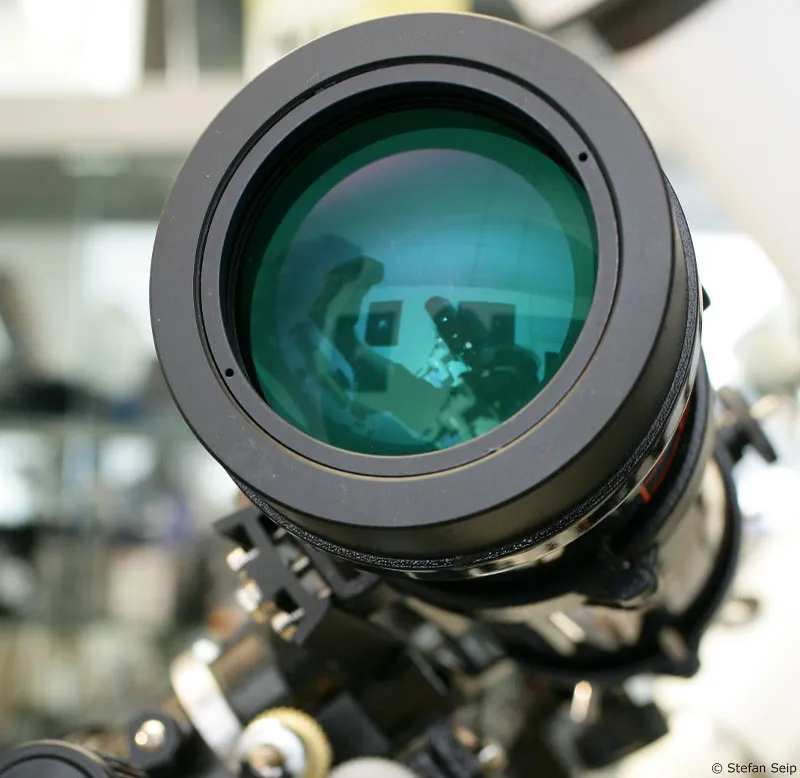
On the left, an image of the Orion Nebula with an achromat. The blue halos around the bright stars as a result of chromatic aberration are clearly visible. A semi-apochromat (ED, right image) reduces this aberration considerably:
| Semi-apochromatic or ED refractor | |
| Typical apertures | 2.5 to 5 inches |
| Typical focal ratios | 1:5 to 1:7.5 |
| Manufacturer (examples) | Skywatcher, William Optics, Meade, Astro-Professional, Teleskop-Service |
| Price range (approx.) | 260 to 1,500 euros |
The advantages and disadvantages of the refractor lie in the following areas:
- Easy handling
- Adjustment of the optics rarely or never necessary
- Quickly ready for use without a long cool-down time
- Best choice for photographing the sun (see tutorial number 6)
- Insensitive to laterally incident stray light
- No obstruction in the beam path due to a secondary mirror (see also reflector telescopes)
- High transmission without significant loss of light due to scattering and reflection
- Star imaging without "rays"
- The (theoretically) best possible imaging performance for a given aperture (apochromat)
- Size and weight above six inches aperture make handling difficult
- Chromatic aberration of achromats
- High price of apochromats
- Apertures from 7 inches only practical as an observatory device
2. the mirror telescope (reflector)
The objective of a reflector telescope consists of a concave mirror which, in a first approximation, is ground into a glass or glass-ceramic material in the shape of a hollow sphere and then provided with a reflective surface. A closer look reveals that, depending on the type of construction, the surface differs slightly from that of a spherical concave sphere.
As the focal point of a concave mirror lies in the beam path, the camera (at least in amateur class telescopes) cannot be mounted directly there as it would block too much of the incident light. For this reason, reflectors have a second mirror, the so-called secondary mirror. It is mounted in front of the focal point and directs the bundled light of the primary mirror out of the tube, where it is then combined in the focal point and the camera can be mounted.
As the secondary mirror is located in the middle of the optical path, it must be held in place with struts, the "secondary mirror spider", which is itself attached to the inner wall of the tube. The secondary mirror together with the "spider" in the beam path is therefore a necessary evil, the consequences of which will be discussed below.
First of all, it is important to note that the secondary mirror is not recognizable in the photo, neither as a sharp nor as a blurred silhouette. Depending on its diameter, however, it does shade part of the incident beam, which results in a loss of brightness. However, this is limited: even a secondary mirror, whose linear diameter is 30 percent of the primary mirror diameter, only shades nine percent of the incident light with its surface.
The second effect of the secondary mirror is a reduction in the general image contrast, which is all the greater the larger the diameter of the secondary mirror. Photographically, this effect is negligible and is only relevant when visually observing planets with their already low-contrast details. The secondary mirror struts, on the other hand, leave visible traces in photographs in the form of "rays" around the bright stars.
The shape of the struts is shown twice, with the second image offset by 180 degrees from the first. A four-armed spider therefore produces four rays on bright stars, one with three rays produces six.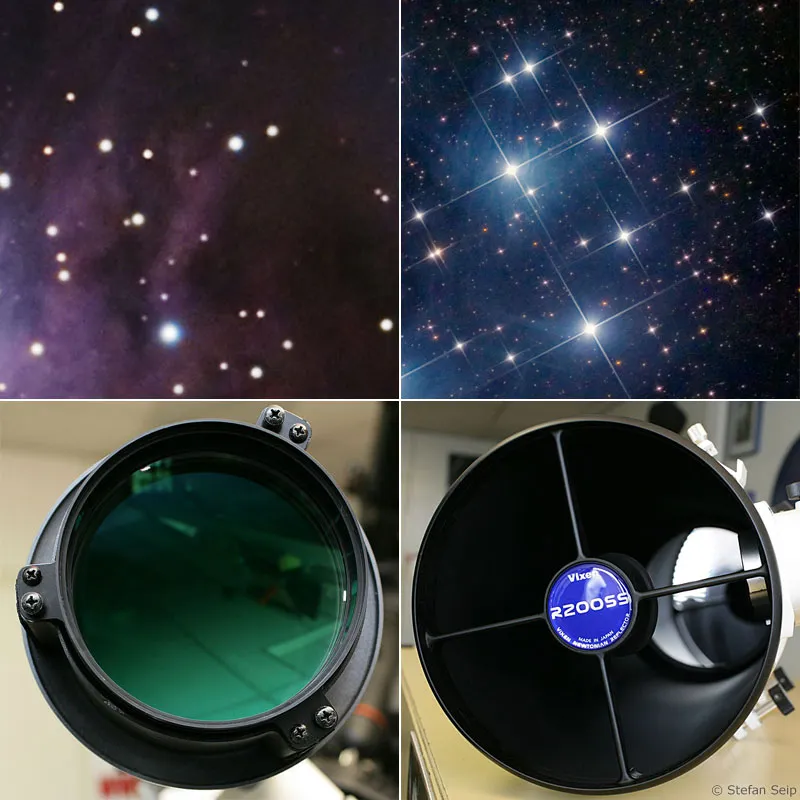
A refractor images stars without "rays" (left). The secondary mirror struts of a Newtonian reflector, on the other hand, produce the image of rays by diffraction of the starlight (right).
Reflecting telescopes are generally free of chromatic aberration because the reflection of light is independent of its wavelength.
Three common types of reflector telescopes are presented below.
2.1 Newtonian reflector
Smaller devices of this type have an inexpensive, spherically ground primary mirror, slightly larger ones have a parabolic mirror, the shape of which deviates from the spherical shape in order to improve the imaging quality. Before reaching the focal point, an elliptical but plane-parallel secondary mirror deflects the light by 90 degrees through a hole in the tube wall. This means that the viewing position or the position of the camera is at the lateral front end of the telescope tube, a somewhat unusual configuration at first. As only a single surface is optically effective with telescopes of this type, they are relatively inexpensive to manufacture.
For photography, models with a large secondary mirror are better suited than those with a small one, in order to illuminate even larger image sensors right into the corners of the image. This is also referred to as a photo-optimized Newtonian telescope or simply a "photo Newtonian". Newtonians can be manufactured with large apertures and "fast" focal ratios, but due to the system, they show the image error coma off the optical axis, which is noticeable as comet-like deformed stars at the edge of the image. An additional lens system in the focuser, a so-called coma corrector, provides a remedy.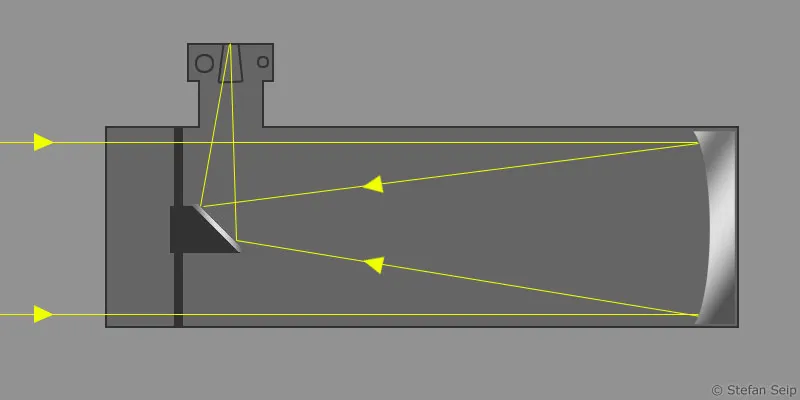
Schematic representation of a Newtonian reflector: The light entering from the left first hits the concave mirror, is bundled by it and deflected out of the tube by a secondary mirror with a flat surface inclined by 45 degrees before reaching the focal point.
The aperture of a Newtonian reflector is located on the side at the front end of the telescope (red arrow).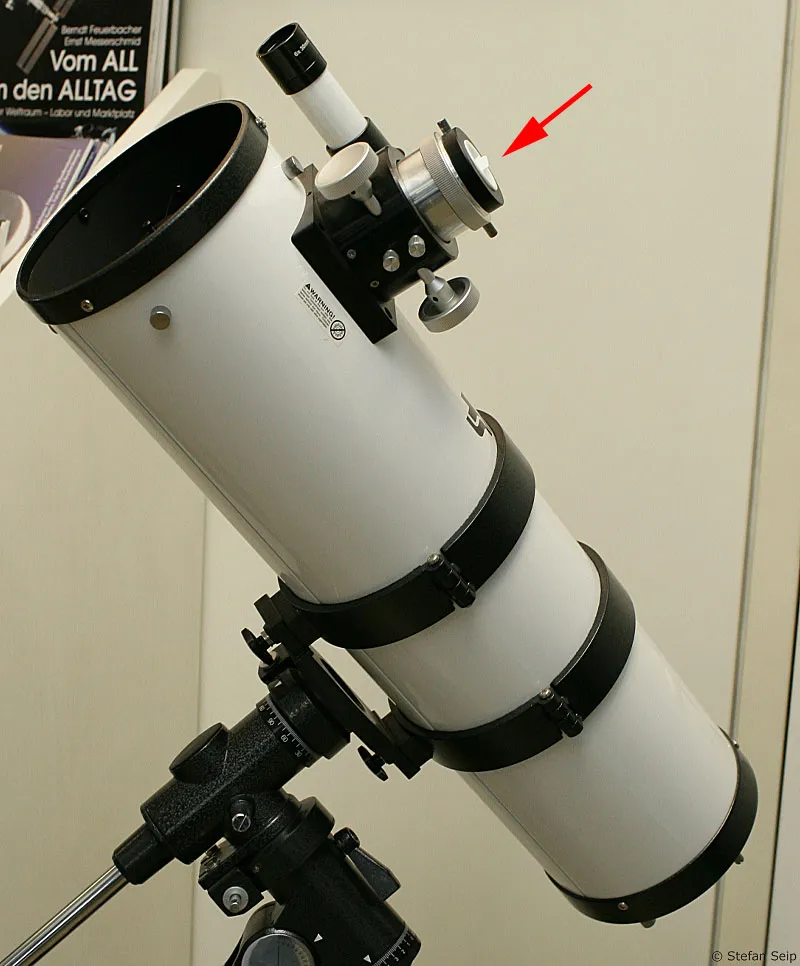
View into the aperture of a Newtonian reflector. You can see the secondary mirror, which is suspended from four thin struts. The primary mirror can be seen far behind. The focuser protrudes to the top right.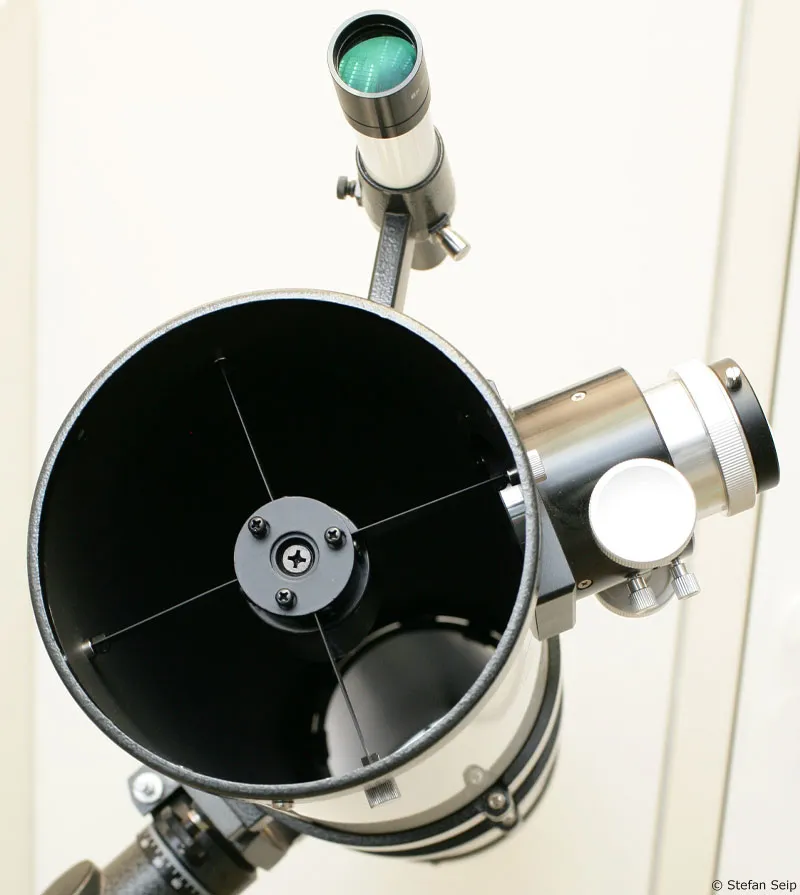
A photographically optimized Newtonian reflector from Vixen. Again, the focuser to which the camera is attached is marked with a red arrow. This device has an 8 inch (200 millimeter) aperture and a focal length of 800 millimeters, which results in a focal ratio of a "fast" 1:4. The telescope costs around 1100 euros without a mount.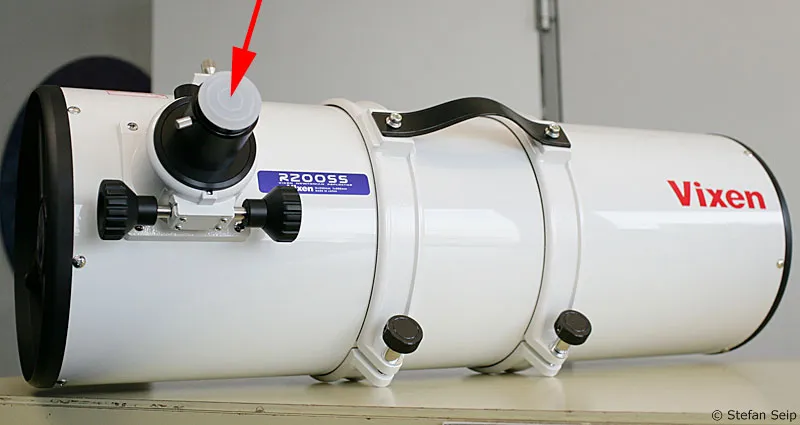
A look into the aperture of the Vixen Photo Newtonian reflector shows that the secondary mirror has a relatively large diameter to illuminate even larger imaging sensors. The struts on which the secondary mirror is suspended are quite thick, but also correspondingly stable.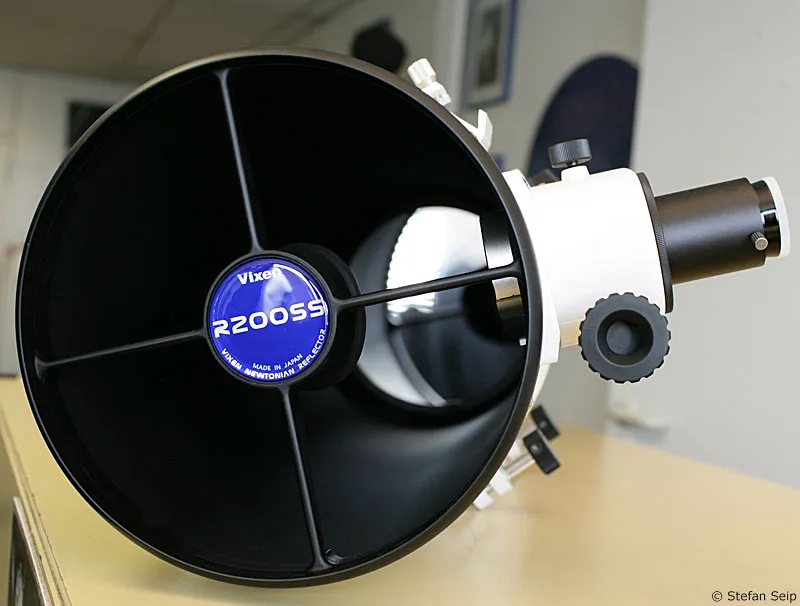
A very simply mounted version of the Newtonian reflector is known as a "Dobsonian telescope". Due to the mount, however, such devices are not suitable for photographic purposes.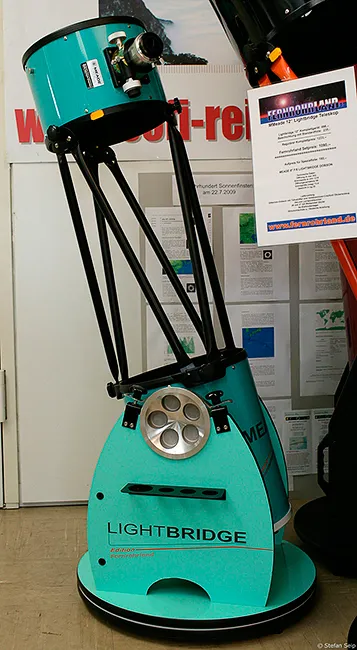
For visual purposes, so-called "Dobsonian" telescopes are very popular. These are very simply mounted Newtonian reflectors, but are not suitable for longer-exposure astrophotography due to their mount.
| Newtonian reflector | |
| Typical apertures | 6 to 12 inches (visually also considerably more) |
| Typical aperture ratios | 1:4 to 1:6 |
| Manufacturers (examples) | Vixen, Skywatcher, GSO, Orion UK, Bresser |
| Price range (approx.) | 280 to 1,500 euros |
2.2 Cassegrain reflector
The primary mirror of this type is also parabolic in shape. However, the secondary mirror is not flat, as with the Newtonian, but convex-hyperbolic (i.e. optically effective) and arranged in such a way that it reflects the beam back towards the primary mirror. This is pierced in the middle so that an eyepiece or camera can be attached to the rear end of the tube. The viewing position thus corresponds to that of a refractor.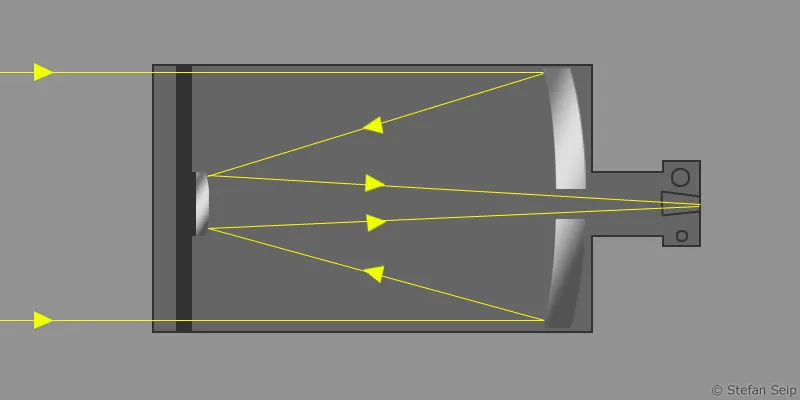
Schematic diagram of a Cassegrain reflector: The primary mirror (right) focuses the incident light onto the secondary mirror (left). This reflects it through a central hole in the primary mirror, where it is finally combined in a focal point outside the tube.
The focuser of a Cassegrain reflector, to which a camera can also be connected, is located at the rear in the viewing direction of the telescope (red arrow), as with a refractor: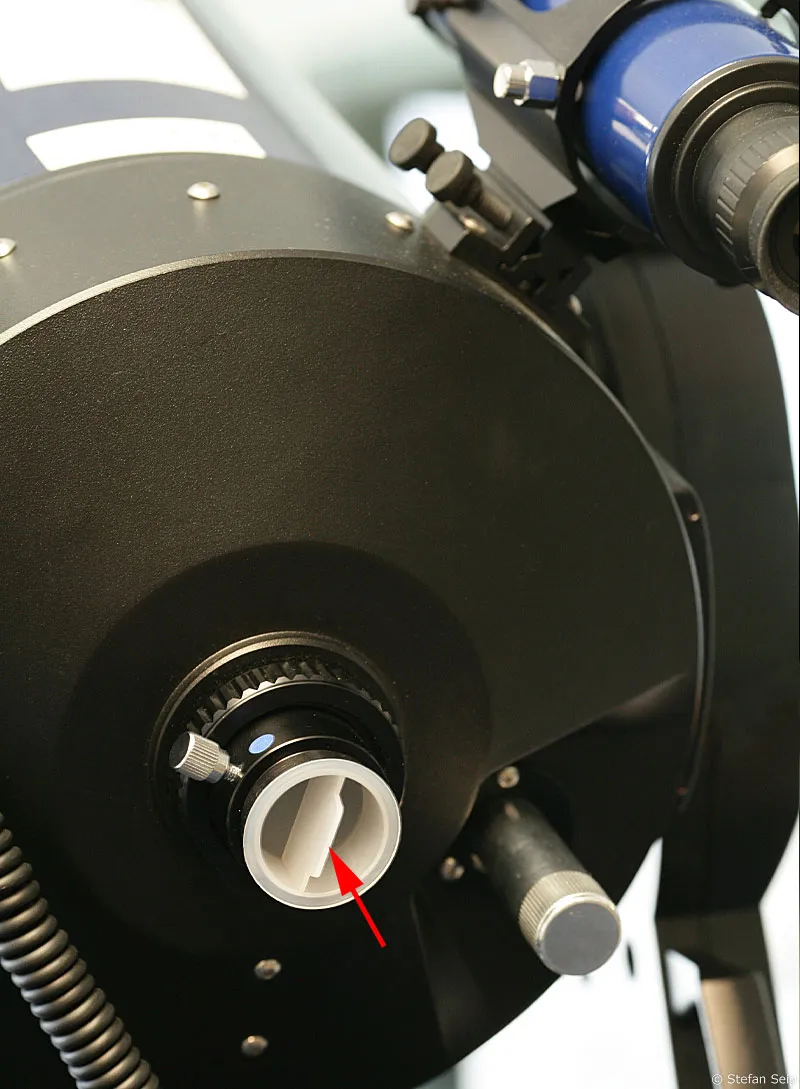
Cassegrain reflectors are now only occasionally found on sale. Their image field is curved and shows aberrations off the optical axis, including coma. Only with an appropriate corrector from a coordinated lens system can these errors be reduced to such an extent that the result is a photographically usable telescope with a sufficiently large field of view for the sensor format of a digital SLR camera.
| Cassegrain reflector (sometimes modified and referred to as Klevzov-Cassegrain) | |
| Typical apertures | 4 to 12 inches |
| Typical aperture ratios | 1:9 to 1:13 |
| Manufacturer (examples) | Vixen, TAL |
| Price range (approx.) | 260 to 14,800 Euro |
2.3 Ritchey-Chrétien reflector
It is very similar to the Cassegrain reflector, but uses two hyperbolic mirror shapes, one for the primary and one for the secondary mirror. This eliminates the coma of the Cassegrains, but not the curvature of the image field, which still has to be countered by a corrector made of lenses. However, this type of construction then delivers good image quality right into the corners of even larger recording sensors. This may be one reason why many of the world's largest telescopes on earth, as well as the Hubble Space Telescope, are designed as Ritchey-Chrétien reflectors.
Such instruments, which are uncompromisingly designed for photographic purposes, are sometimes also referred to as astrographs. Many of the Ritchey-Chrétien reflectors are only produced with a relatively large aperture and are quite expensive. They are therefore reserved for the ambitious amateur.
Schematic representation of the Ritchey-Chrétien reflector: The beam path is absolutely identical to that of a Cassegrain reflector; only the two mirrors have a slightly different surface shape, so that image errors off the optical axis are better corrected:
A Ritchey-Chrétien reflector with a 20 inch (50 centimeter) aperture is almost a professional device. The telescope from RCOS, USA, alone costs 46,000 euros, without mount.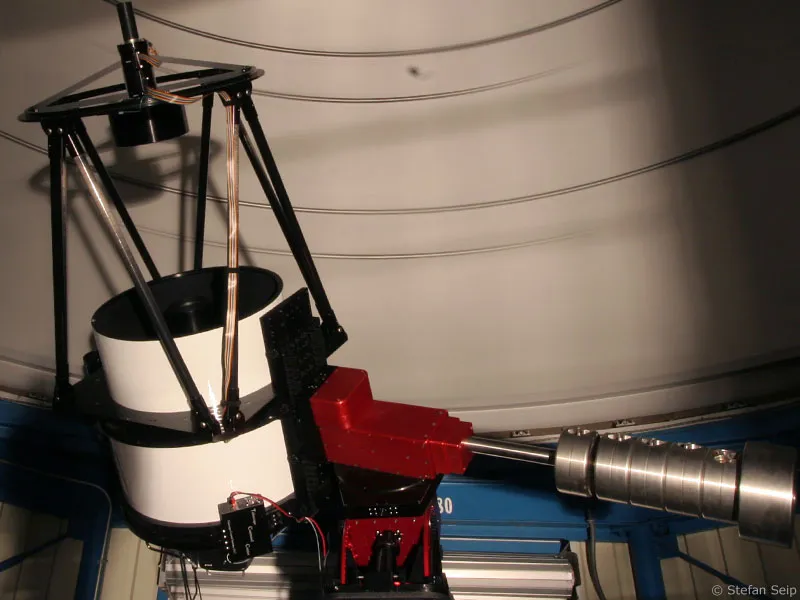
| Ritchey-Chrétien reflector (RC) | |
| Typical apertures | 6 to 16 inches |
| Typical aperture ratios | 1:8 to 1:9 |
| Manufacturer (examples) | GSO, Astro-Systems Austria, RCOS USA |
| Price range (approx.) | 900 to 25,000 euros |
The advantages and disadvantages of a reflector can be summarized as follows:
- Large apertures at relatively low acquisition costs (Newtonian)
- No chromatic aberration
- Some fast versions available (Newtonian)
- Medium cooling times thanks to a tube open at the front
- Very high image quality for large image sensors (Ritchey-Chrétien with field flattening lens)
- Construction length significantly shorter than the effective focal length (Cassegrain, Ritchey-Chrétien)
- Dirt can get onto the primary mirror through the open tube
- Adjustment of the mirrors (collimation) necessary from time to time
- Loss of light and contrast due to the secondary mirror in the beam path
- Loss of light due to the limited reflectivity of the mirrors
- Only limited use for solar observations
- Limited use for terrestrial observations during the day (e.g. birds)
- Radiation around bright stars due to the secondary mirror struts
Three pairs of screws (one push and one pull screw) allow fine adjustment of the primary mirror with a Newtonian reflector. The picture shows the rear side of the tube.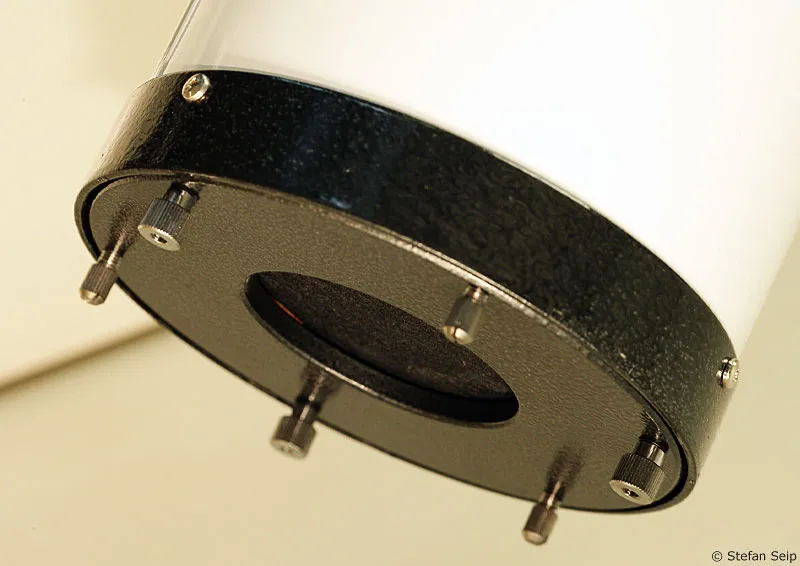
The secondary mirror of a Newtonian reflector can be brought into its optimum position with three further screws. Adjusting the optics of a Newtonian telescope is not rocket science, but must first be learned.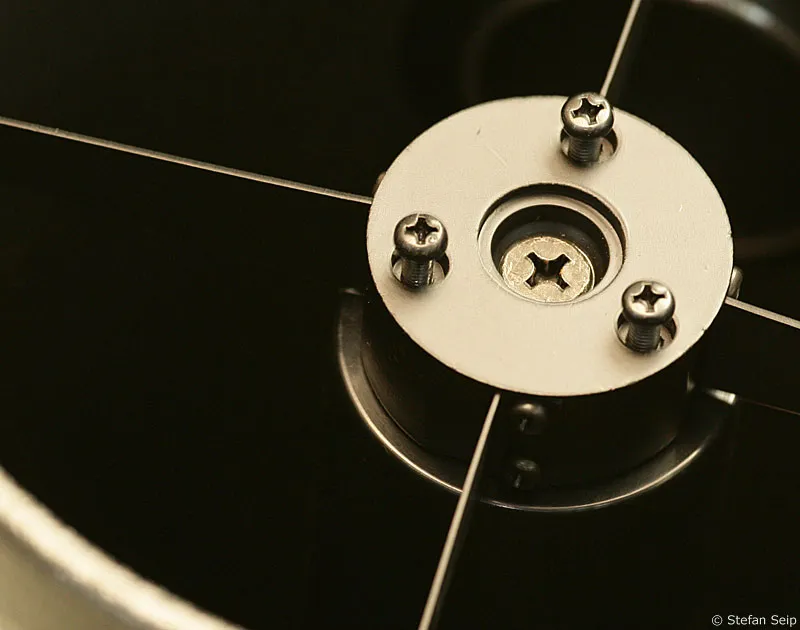
3. the catadioptric system
Catadioptric telescopes use mirrors and lenses to produce images, but are based on the Newtonian and Cassegrain reflectors described above under reflector telescopes. The idea of using an additional lens element at the front end, i.e. in the area of the entrance pupil, is based on the desire to improve the image quality away from the optical axis, often in combination with a surface shape of the primary mirror that is easier and therefore cheaper to produce. The lens element used results in a longitudinal chromatic aberration which, however, is minimal - compared to an achromatic refractor - and hardly noticeable in practice. If the additionally inserted lens is thin and aspherically ground, it is also referred to as a "Schmidt plate" and the telescope designation is preceded by "Schmidt-". If the lens is a relatively thick, spherically manufactured meniscus element, it is referred to as a "Maksutov telescope".
The lens also serves as a mounting option for the secondary mirror, so that the secondary mirror mount can be omitted and no rays are produced in bright stars.
3.1 Schmidt-Cassegrain
The design roughly corresponds to a Cassegrain reflector, supplemented by an aspherical Schmidt plate. This allows a spherical (spherical) shape of the primary mirror, which is therefore cheaper to manufacture. At the same time, the coma is reduced, which theoretically results in good imaging performance. Unfortunately, the production of the aspherical Schmidt plate is problematic. It is not always possible to achieve the desired accuracy, meaning that the effective performance of some Schmidt-Cassegrain telescopes falls short of expectations. Nevertheless, this type of telescope was very popular with amateurs for a long time because relatively large apertures and focal lengths can be achieved with moderate telescope dimensions. Another problem with many models is that they do not succeed in illuminating the large sensors of digital SLR cameras - strong vignetting in the form of dark image corners spoils the image.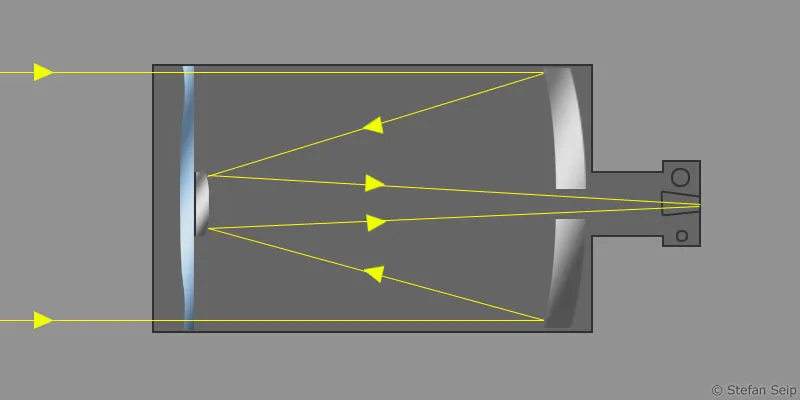
Schematic diagram of a Schmidt-Cassegrain telescope: In contrast to a Cassegrain reflector, there is a front lens known as a Schmidt plate. It is aspherically shaped and enables cheaper mirrors and correction of image errors off the optical axis.
Celestron is the best-known manufacturer of Schmidt-Cassegrain telescopes. The model shown here has an aperture of 8 inches (200 millimetres) and a focal length of 2000 millimetres, i.e. an aperture of 1:10. The rather large secondary mirror is attached to the Schmidt plate, eliminating the need for support struts. The primary mirror can be seen through the coated Schmidt plate. The tube without the mount is available for around 1150 euros.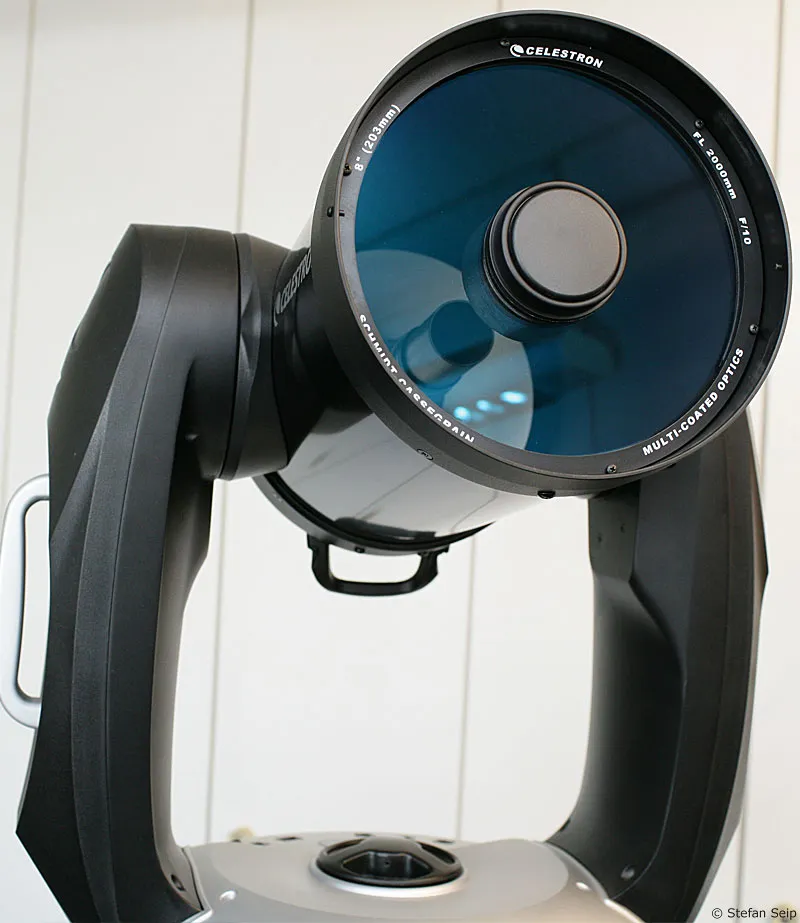
Only the secondary mirror can be adjusted on this telescope. After removing the central cover, the corresponding adjustment screws appear.
| Schmidt-Cassegrain (SC) | |
| Typical apertures | 6 to 14 inches |
| Typical aperture ratios | 1:10 |
| Manufacturer (examples) | Celestron |
| Price range (approx.) | 600 to 6,500 Euro |
3.2 Maksutov-Cassegrain
In principle, it corresponds to the Schmidt-Cassegrain, except that a meniscus lens is used instead of the Schmidt plate. All surfaces are spherical and can therefore be produced inexpensively and with high precision. The secondary mirror consists of a surface coated with a reflective layer on the back of the meniscus lens. The optical principle allows high image quality and is used particularly in very compact, smaller telescopes and in some photographic lenses. As the aperture increases, a Maksutov-Cassegrain telescope becomes quite heavy due to the thick meniscus lens.
Due to the usually "slow" aperture ratios, faint deep-sky objects have to be exposed for a long time. The Maksutov-Cassegrain shows its advantages especially when photographing the moon and planets.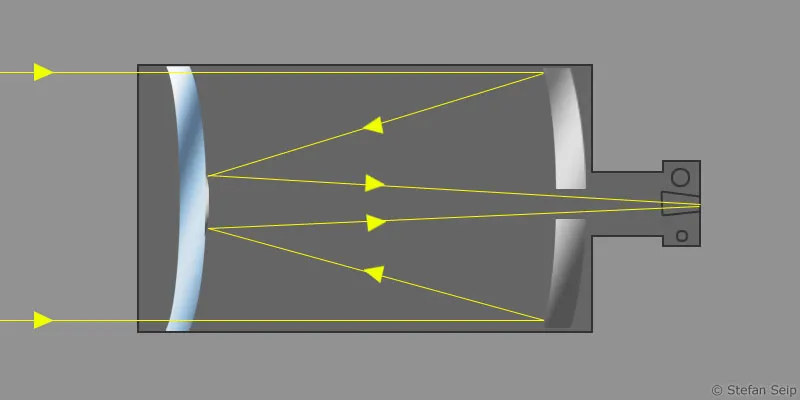
Schematic diagram of the Maksutov-Cassegrain telescope: The beam path corresponds to that of a Schmidt-Cassegrain, except that instead of the Schmidt plate a spherically ground meniscus lens is used, on the back of which the secondary mirror is vapor-deposited.
This handy Maksutov-Cassegrain telescope from Meade has an aperture of 5 inches (127 millimetres to be exact) and a focal length of 1800 millimetres, which means that it has a rather low focal ratio of 1:15. The moon and the planets are particularly suitable targets for such an optical system. Unfortunately, this telescope is only available including the fork mount; the price is then 900 euros.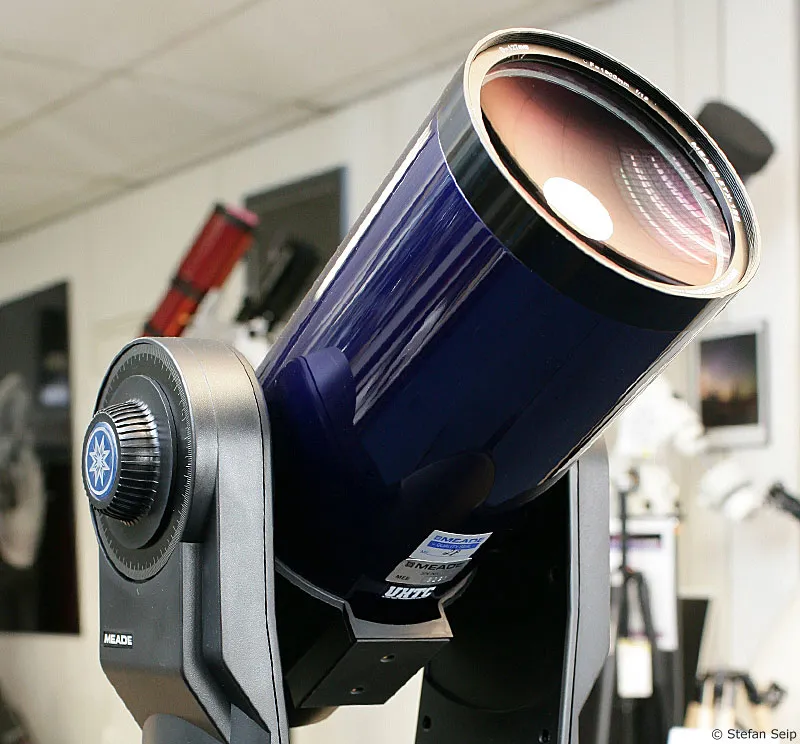
The view from the front of the Maksutov-Cassegrain telescope shows the coated meniscus lens, on the back of which the secondary mirror is vapor-deposited, clearly visible here as a reflective, bright disk.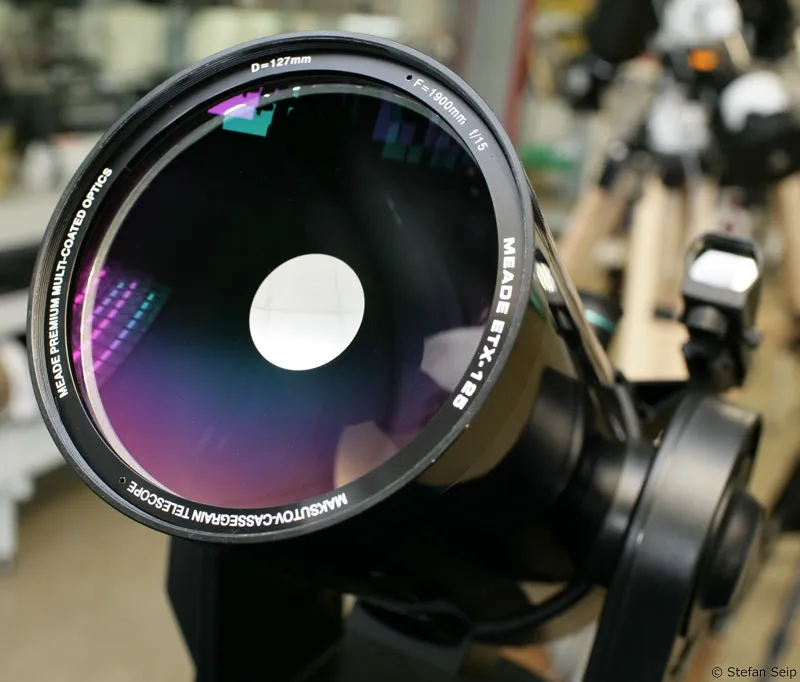
| Maksutov-Cassegrain (MC) | |
| Typical apertures | 3.5 to 12 inches |
| Typical aperture ratios | 1:10 to 1:15 |
| Manufacturer (examples) | Meade, Intes Micro, Skywatcher |
| Price range (approx.) | 150 to 20,000 euros |
3.3 Schmidt-Newtonian
The beam path essentially corresponds to that of a Newtonian reflector, except that a corrector lens is attached in the area of the telescope's entrance aperture. Much of what has been said about the Schmidt-Cassegrain also applies to the Schmidt-Newton. The corrector lens allows the use of a spherical primary mirror and reduces the coma that occurs. However, the not unproblematic production of the Schmidt plate can also impair the overall performance of this system. Fast, bright optics are available.
Schematic representation of the Schmidt-Newton telescope: In contrast to a Newton reflector, this telescope contains a Schmidt plate as a front lens. This in turn serves as a mounting option for the secondary mirror, so that the support struts can be omitted.
This Schmidt-Newtonian telescope from Meade has an aperture of 8 inches (200 millimetres) and a focal length of 810 millimetres, resulting in a "fast" focal ratio of 1:4. The Schmidt corrector lens, in the center of which the secondary mirror is attached, is clearly visible. The price for such a telescope is around 715 euros.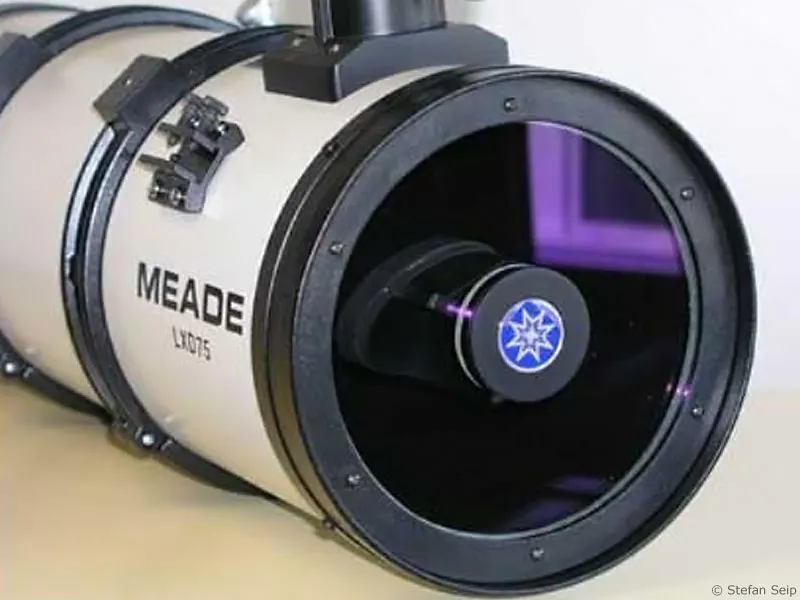
| Schmidt-Newton (SN) | |
| Typical apertures | 6 to 10 inches |
| Typical aperture ratios | 1:4 |
| Manufacturer (examples) | Meade |
| Price range (approx.) | 500 to 1,500 Euro |
3.4 Maksutov Newtonian
Again, the Newtonian reflector serves as the starting point, supplemented by a meniscus lens in the entrance aperture to correct the image errors of the spherical primary mirror. Devices with a very small secondary mirror are available on the market. These are only ideal for high-resolution images of the moon and planets, while they are not able to illuminate the sensor of a digital SLR camera without vignetting due to the size of the secondary mirror.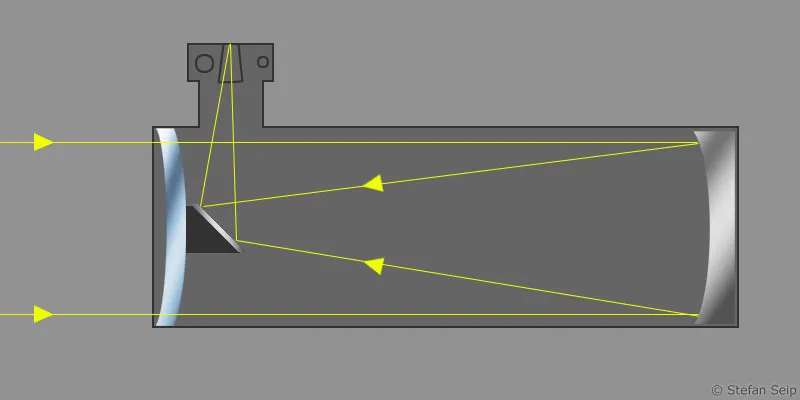
Schematic representation of the Maksutov-Newton telescope: A meniscus lens serves as the front lens, otherwise it is essentially the same as the Schmidt-Newton telescope.
This Maksutov-Newton telescope from Intes Micro has a seven-inch aperture (180 millimetres) and a focal length of 1080 millimetres (f/6 aperture). The view is sideways and upwards (red arrow). The pictured device with first-class optics costs around 1800 euros.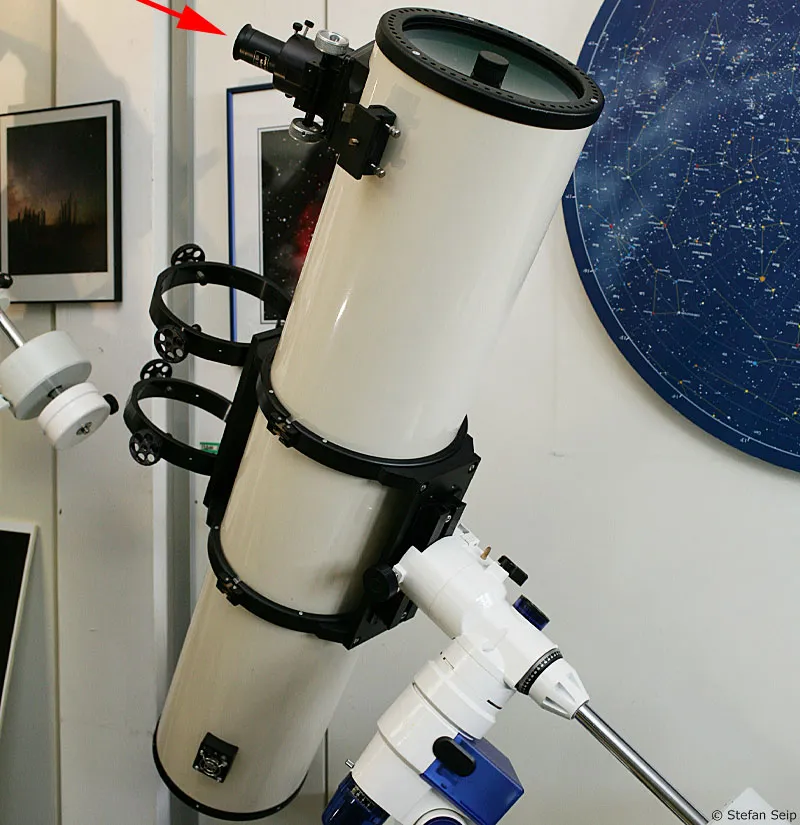
The meniscus lens of the Maksutov Newtonian presented below carries the very small secondary mirror in its center, which linearly accounts for only 18 percent of the total diameter. Optionally, the device can also be ordered with an aperture of 1:8, in which case the secondary mirror is even smaller (13 percent of the aperture). Although these small secondary mirrors ensure excellent image contrast, they do not even illuminate the sensor of a digital SLR camera with a "crop factor". This makes them specialists for detailed images of the moon and planets.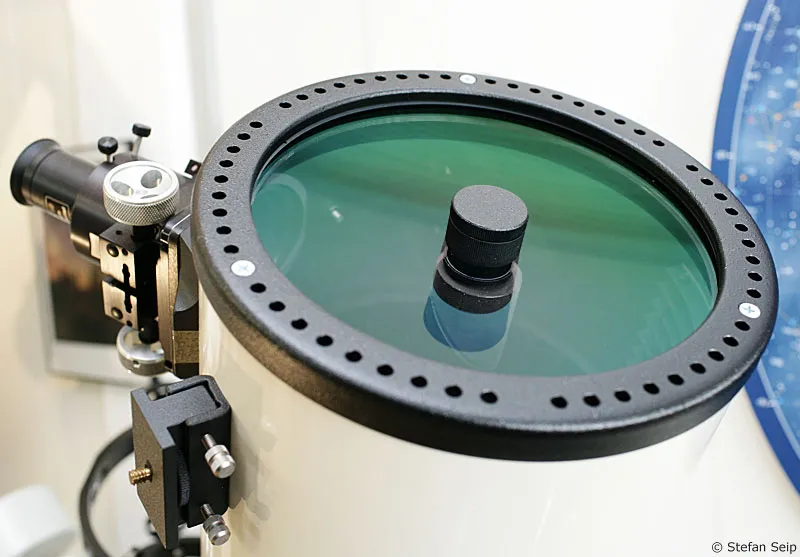
This Maksutov Newtonian from Bresser looks almost like a normal Newtonian reflector, whose secondary mirror seems to float in the air because the very effective coating of the meniscus lens suppresses almost all light reflections. The view is - typical for Newtonians - sideways (red arrow). The device has an aperture of around 6 inches (152 millimeters) and a focal length of 740 millimeters, which corresponds to a focal ratio of 1:5. The price is around 1000 euros.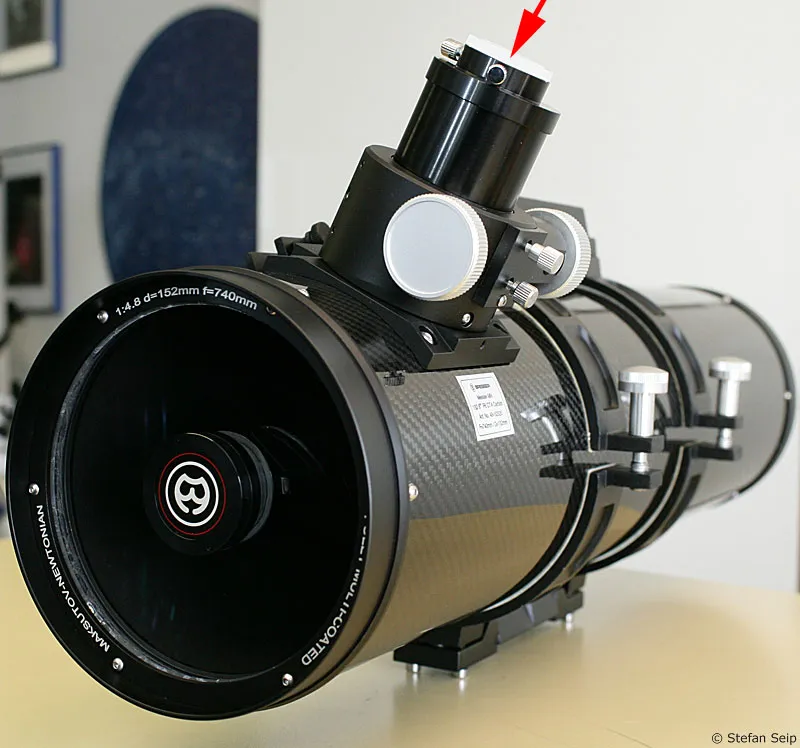
The secondary mirror of the Bresser Maksutov Newtonian is significantly larger than that of the Intes Micro model. However, it is capable of illuminating sensors in APS-C format (digital SLR camera with 1.6x crop factor).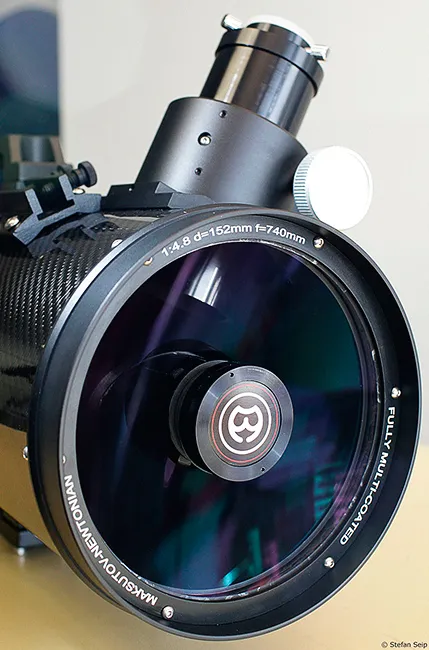
| Maksutov Newtonian (MN) | |
| Typical apertures | 5 to 14 inches |
| Typical focal ratios | 1:4 to 1:8 |
| Manufacturer (examples) | Intes Micro, Bresser |
| Price range (approx.) | 950 to 20,000 euros |
Variants
In addition to the designs described, there are also numerous variations that must be considered exotic. Many of them promise even better imaging performance than the "original" by slightly modifying the surface shape of the primary and/or secondary mirror and/or the corrector lens.
One example is the "Advanced Coma-Free" telescopes from Meade, whose imaging performance has been increased compared to a Schmidt-Cassegrain.
Relatively new on the market are telescopes from Meade, which are called "Advanced Coma-Free" telescopes by the manufacturer. Due to this further development, Meade no longer has any Schmidt-Cassegrain telescopes in its range. Pictured is the model with 8 inch aperture (200 millimeters). The focal length is 2000 millimeters (Blender 1:10). You should start with a shorter focal length, as the exact tracking of such a telescope with long exposure times is no easy task. You will have to pay around 1380 euros for the tube without mount.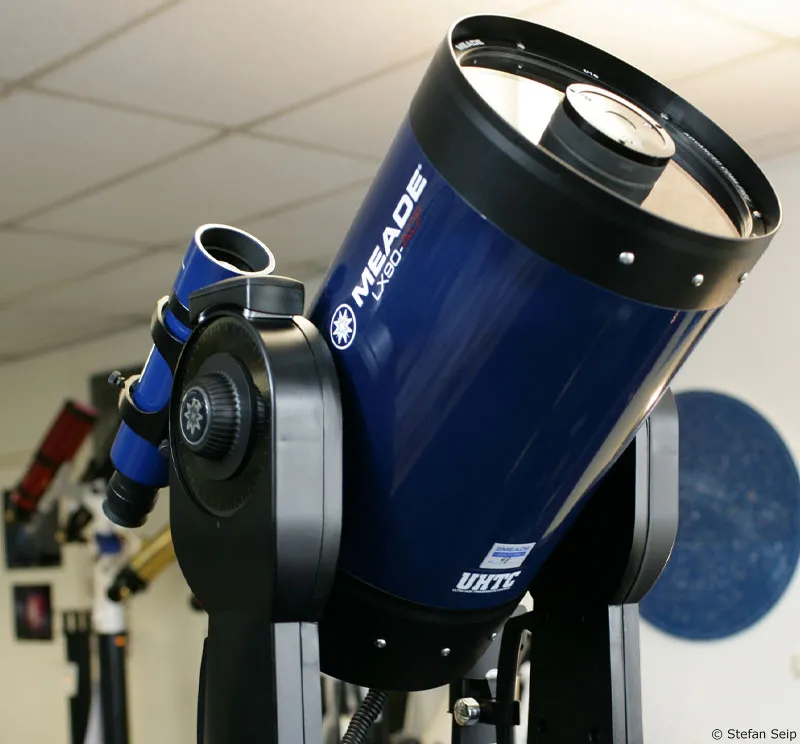
View from the front of the Advanced Coma-Free telescope. The coating of the front lens is of very high quality, as it eliminates almost all reflections - the secondary mirror appears to float in the air. You can also see the adjustment screws of the secondary mirror and the primary mirror further back in the tube. The linear diameter of the secondary mirror is an impressive 38% of the aperture. It shades 14 percent of the area of the entrance pupil - both are acceptable in photographic use.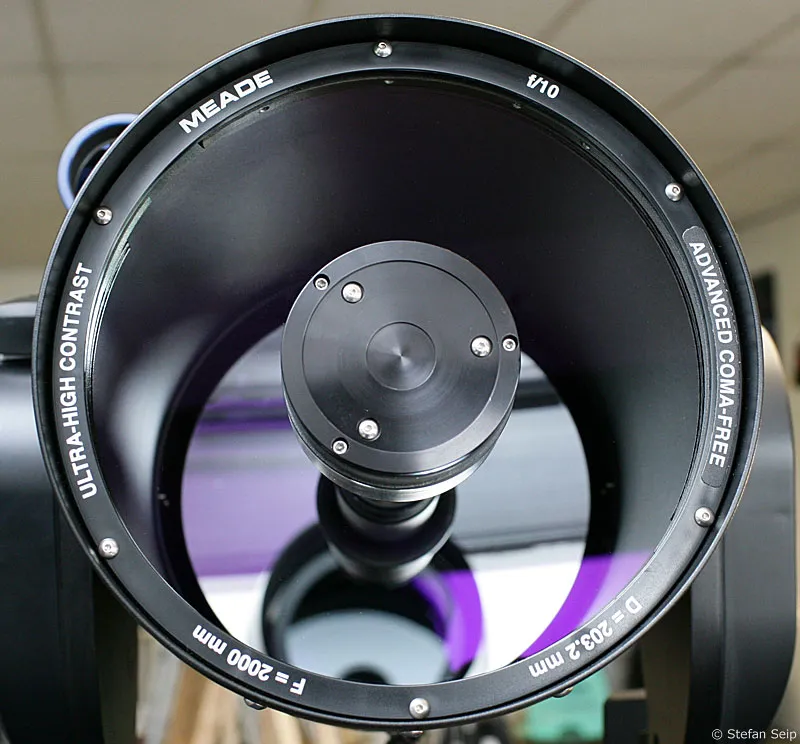
| Meade "Advanced Coma-Free" telescope | |
| Typical apertures | 8 to 16 inches |
| Typical aperture ratios | 1:8 to 1:10 |
| Manufacturer: Meade | Meade |
| Price range (approx.) | 1,400 to 15,000 euros |
The advantages and disadvantages of catadioptric telescopes in brief:
- Closed system, therefore low risk of contamination of the primary mirror
- Practically no chromatic aberration
- Construction length significantly shorter than the effective focal length (except Schmidt-Newton and Maksutov-Newton)
- No ray formation around bright stars because there are no secondary mirror struts
- High image quality with careful design
- Long cooling times (e.g. after transportation from a heated apartment to the outside)
- Adjustment of the mirrors (collimation) necessary from time to time
- Loss of light and contrast due to the secondary mirror in the beam path
- Loss of light due to the limited reflectivity of the mirrors
- Only limited use for solar observations
- Limited use for terrestrial observations during the day (e.g. birds)
- Large front lens susceptible to dew fogging
- High weight (especially the Maksutov devices)
The following table lists the most important systems and their suitability for astrophotography, two refractors, two reflectors and two catadioptric systems. As no type of telescope is equally suitable for all applications, the table contains a classification according to the various astronomical subjects.
| Achromat | Apochromat | Newtonian | Ritchey-Chrétien | Schmidt-Cassegrain | Maksutov-Cassegrain | |
| Planets | - | + | + | + | + | ++ |
| moon | + | ++ | ++ | ++ | ++ | ++ |
| sun | + | ++ | o | o | o | o |
| Sun in H-alpha light | + | ++ | - | - | - | - |
| Large deep-sky objects | o | ++ | + | ++ | - | - |
| Small deep-sky objects | - | + | + | ++ | + | ++ |
| Daylight shots | o | + | - | - | o | o |
Recommendation
Facts are one thing, opinions are another. Therefore, from my subjective point of view, I would like to make a concrete recommendation.
For newcomers to astrophotography who are equipped with a digital SLR camera and want to take long-exposure images of faint celestial objects, I would recommend a small, apochromatic refractor with a focal length of between 400 and 600 millimetres. This keeps the problems of exact tracking during the exposure time within limits, although a whole host of attractive subjects (star clusters, gas nebulae, galaxies) are still within reach. Such a device is compact and absolutely easy to handle if the aperture is a maximum of four inches. The required mount (see tutorial number 9 of the "Astrophotography and Sky Photography" series) is also within reasonable limits in terms of weight and price. If a budget problem arises, a semi-apochromat or ED refractor can be a viable alternative. In any case, you should check whether a functioning field flattening lens is available for the model of your choice before making a purchase.
A Barlow lens can be used to extend the effective focal length of such a refractor, allowing you to take detailed images of the moon. You can also take photos of the sun in white light or H-alpha light with such a telescope (see tutorial number 6 in the "Astrophotography and sky photography" series).
If longer focal lengths (1000 to 1500 millimetres) are to be used later, with the experience gained, it is more difficult to make specific recommendations. For deep-sky objects with long exposure times, a Newtonian reflector with coma corrector, a Schmidt-Newtonian or a Maksutov-Cassegrain telescope may be an option if you don't really want to dig deep into your pockets and want to purchase a large apochromatic refractor (up to six or seven inches aperture) or a Ritchey-Chrétien reflector as the ultimate solution.
If you are mainly interested in planetary photography and detailed photos of the moon, you will need to use long and very long focal lengths, but you may prefer to work with a web or video camera (see tutorial number 14 of the series "Astrophotography and Sky Photography") instead of a digital SLR camera. Then the requirement for a large, well-lit field of view no longer applies and the options become more extensive. A Schmidt-Cassegrain, Maksutov-Cassegrain, Maksutov-Newtonian and a long focal length Newtonian reflector, each with apertures of eight to fourteen inches, can then be considered.
Acknowledgments
I would like to thank the company Fernrohrland, Fellbach(www.fernrohrland.de). They allowed me to take a large number of the telescope images contained in this tutorial and to discuss the current market situation in lengthy conversations, without which this tutorial would not be complete.
All prices quoted are approximate as of April 2009.
